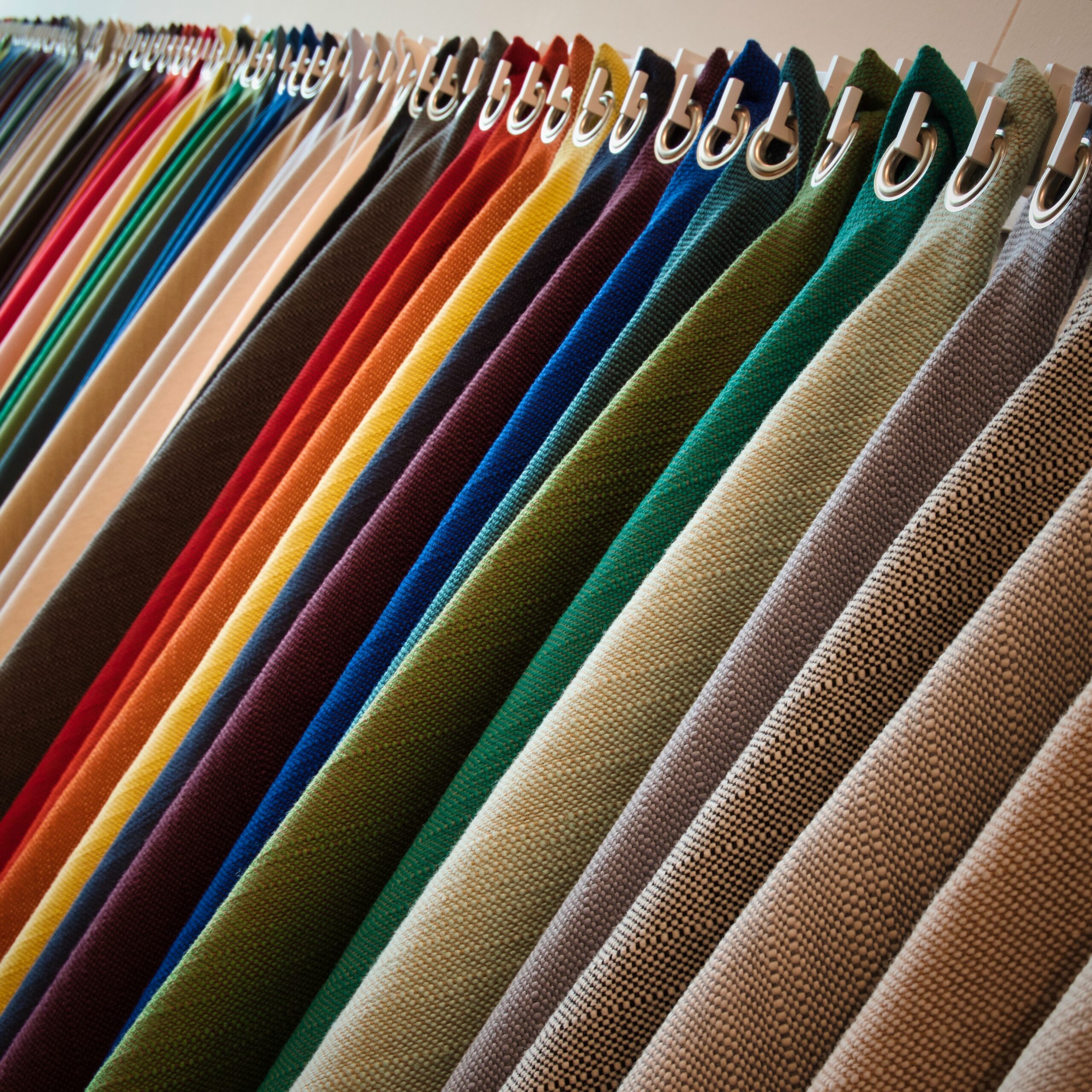Explanation of various curtain materials
This article provides a detailed explanation of each type of material used for curtain fabric .
natural fibers
cotton
Advantages of cotton
- Natural and gentle texture.
- Durable and absorbent.
- Soft texture.
Disadvantages of cotton
- Because it is easily dyed, it is prone to staining and color transfer.
- It tends to become fluffy due to friction such as washing.
- susceptible to mold attack.
- It tends to yellow when exposed to sunlight for a long time.

Linen
Advantages of Linen
- Excellent water resistance and heat resistance.
- Water absorbent, moisture permeable, and breathable.
- The smooth feel is comfortable.
- Beautiful colors, colors that blend in.
Disadvantages of Linen
- The fabric expands and contracts due to changes in moisture content.
- Due to the lack of drapability, the waves of the curtains are rather simple.
- Easy to wrinkle.

wool
Advantages of wool
- Chic and warm texture.
- Low thermal conductivity and high heat retention.
- Does not easily get dirty.
Disadvantages of wool
- It will shrink when washed.
- Easy to be eaten by insects.

silk
Advantages of silk
- Elegant luster and smooth texture.
- Good dyeability and beautiful coloring.
- Wrinkle resistant.
Disadvantages of silk
- It is sensitive to sunlight and yellows easily.
- Weak against friction.
- Easily attacked by insects and mold.
- When it gets wet, it shrinks and tends to stain.

Chemical fiber
Chemical fibers are mainly classified into the following three types.
- “Synthetic fibers” chemically synthesized from petroleum
(polyester, new synthetic fibers, acrylic, nylon, etc.) - “Regenerated fibers” made from wood pulp and cotton fibers
(rayon, cupro, polynosic) - “Semi-synthetic fiber” made from pulp cellulose and milk protein casein
(Acetate, Promix)
The story may seem complicated, but you may be familiar with the names of chemical fibers such as “polyester” and “rayon.”
Synthetic fibers are characterized by a high degree of freedom in processing, and are attractive in that they can be added with special functions such as waterproofing, water repellency, UV protection, and pollen catching.
Other benefits include its reasonable price, ease of dyeing, and less tendency to lose its shape or shrink when washed, making it a recommended material for those looking for easy-to-use curtains.
polyester
Advantages of polyester
- Strong and flexible.
- Wrinkle resistant.
- Easy to process.
- Good stainability.
- Relatively reasonable.
- Easy to clean.
Disadvantages of polyester
- It is electrostatically charged and can easily accumulate static electricity.
- Easy to absorb dust.
- It has poor moisture absorption and gets stuffy easily.
New synthetic fiber
Advantages of new synthetic fibers
- breathable
- Less deformation
- Wrinkle-resistant
- Light and soft material
Disadvantages of new synthetic fibers
- Poor air circulation
- Off-gassing
- Fire hazard
- Not environmentally friendly
Acrylic
Its a material often used in medical products such as knitwear and socks, and is made from a petroleum called acrylonitrile.
Among synthetic fibers, it has properties that are most similar to wool, and is characterized by being fluffy, soft, and has strong elastic recovery (ability to return to its original shape).
It is sometimes used in curtains by blending it with other fibers.
Advantages of Acrylic
- Fluffy and soft texture.
- Wrinkle resistant.
- Resistant to chemicals and insects.
- It does not easily shrink or lose its shape when washed.
Disadvantages of Acrylic
- Static electricity is likely to occur.
- Easy to pill.
Rayon
Rayon is a material developed as a substitute for silk, and is known for its shiny, smooth texture and beautiful drape.
A chemical fiber made by dissolving the main raw material such as wood pulp with cellulose chemicals and regenerating it.
It is also called “viscose rayon”.
Advantages of Rayon
- A classy and elegant texture.
washed. - Excellent hygroscopic and water absorbing properties.
- Easy to dye and the color is beautiful.
Disadvantages of Rayon
- Weak against friction.
- It is sensitive to water and tends to shrink when washed.
Acetate
Acetate is a material classified as a semi-synthetic fiber.
A fiber made from wood pulp as the main raw material and processed by chemically applying acetone.
It has the softness and luster of silk, and has the advantage of being easy to pleat.
Advantages of Acetate
- Excellent heat retention, moisture absorption, and elasticity.
- It has a fluffy wool-like texture and a light impression.
- Easy to dye and the color is beautiful.
Disadvantages of Acetate
- It is sensitive to heat and friction, and has low chemical resistance.
- Low heat resistance
- Difficult to clean
- Not breathable
- Not environmentally friendly
.
Acrylic series
Advantages of Acrylic series
- It has good color development and does not yellow or fade due to sunlight.
- Resistant to sunlight.
- It is elastic and wrinkle-resistant
- Soft, light, and highly heat-retaining.
- Excellent flame resistance.
Disadvantages of Acrylic series
- Hairballs are likely to occur.
- Weak against heat.
- Off-gassing
- Fire hazard
Nylon
Advantages of Nylon
- Not easily attacked by mold and insects.
- Easy to dye, flexible and thin
- It does not lose its shape and is highly elastic.
- Resistant to wear and bending.
Disadvantages of Nylon
- Price is a little high.
- Easily charged with static electricity.

Pingback: Cleaning and Maintenance Tips-Trending in 2023
Pingback: Diy curtains for old style houses -
Pingback: Blue and White Drapes 2023
Pingback: how to make diy blackout curtains -